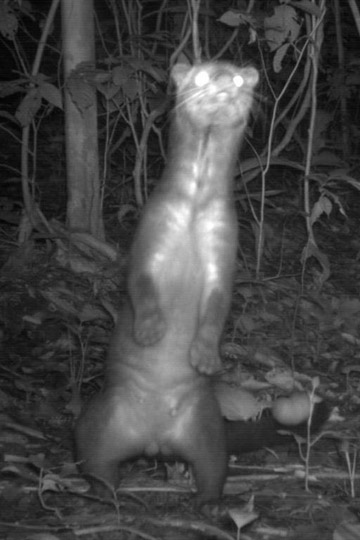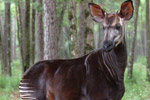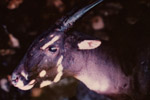Harnessing big data for conservation.
The world’s largest remote camera trap initiative—monitoring 275 species in 17 protected areas—is getting some big data assistance from Hewlett-Packard (HP). To date, the monitoring program known as the Tropical Ecology Assessment and Monitoring (TEAM) Network has taken over 1.5 million photos of animals in 14 tropical countries, but conservationists have struggled with how to quickly evaluate the flood of data.
“Until now, the right data, the technology and scale have been noticeably missing from our field,” noted Peter Seligmann head of Conservation International (CI), a partner of TEAM. “What once took a team of scientists weeks, months or more to analyze can now be done by a single person in hours.”
 Banded mongoose in Tanzania’s Udzungwa National Park. Photo courtesy of TEAM/Conservation International. |
The data jump has been provided by HP Earth Insights, a collaboration between the information technology company and CI. HP Earth Insights’ Wildlife Picture Index software provides conservationists near-real-time data on the photos, including species frequency and climatic conditions. To date, the index does not include species-recognition data—that still needs to be done by conservationists—however HP hopes to add that in the future.
Still, the Wildlife Picture Index is providing key new insights. According to the program, 60 species out of the 275 being monitored—or more than one in five—are likely seeing population declines. Such findings are alarming, especially given these are animal populations found in protected areas.
Moreover, the data shows signs that a number of species thought secure are actually facing declines. For example, populations of moonrats (Echinosorex gymnura), masked palm civets (Paguma larvata) and wild boar (Sus scrofa) are falling in Malaysia’s Pasoh Forest Reserve, while the large treeshrew (Tupaia tana) is vanishing from Indonesia’s Bukit Barisan National Park. In Latin America, the greater grison (Galictis vittata) is on the decline in Ecuador’s Yasuni National Park while the northern tamandua (Tamandua mexicana) is having trouble in Volcàn Barva National Park. The data is showing similar stories in Africa: in the Republic of Congo’s Nouabalé-Ndoke National Park the agile mangabey (Cercocebus agilis) is in decline, while the banded mongoose (Mungos mungo) and the four-toed elephant shrew (Petrodromus tetradactylus) are seeing falling populations in Tanzania’s Udzungwa National Park. Notably, all nine of these species are currently considered as Least Concern by the IUCN Red List.
“We thought these animals were abundant,” Jorge Ahumada, the head of TEAM, told the Wall Street Journal. “We assumed they were fine.”
Endangered species are also seeing population declines. Sun bears (Helarctos malayanus), considered Vulernable, are declining in Pasoh Forest Reserve and the Critically Endangered western gorilla (Gorilla gorilla) has seen its population fall 10 percent in just four years in Nouabalé-Ndoke National Park in the Republic of Congo.
Conservationists hope to use this near-time data to increase protections and lobby policy-makers.
“We can’t protect what we don’t measure, which is why CI is extremely focused on accelerating our research and having the most accurate and current data to ensure that we are doing the very best to safeguard our natural resources,” added Seligman.
TEAM is currently taking photos in seventeen parks:
- Barro Colorado Nature Monument – Soberania National Park (Panama)
- Bukit Barisan Selatan National Park (Indonesia)
- Bwindi Impenetrable Forest (Uganda)
- Caxiuanã National Forest (Brazil)
- Central Suriname Nature Reserve (Suriname)
- Cocha Cashu National Park (Peru)
- Manu National Park (Peru)
- Korup National Park (Cameroon)
- Manaus (Brazil)
- Nam Kading National Protected Area (Lao PDR)
- Nouabalé Ndoki (Republic of Congo)
- Pasoh Forest Reserve (Malaysia)
- Ranomafana National Park (Madagascar)
- Udzungwa Mountains National Park (Tanzania)
- Volcan Barva Transect (Costa Rica)
- Yanachaga-Chemillén National Park (Peru)
- Yasuni National Park and Biosphere Reserve (Ecuador)

Western gorilla in Nouabalé-Ndoke National Park in the Republic of Congo. Photo courtesy of TEAM/Conservation International.

Moon rat in Malaysia’s Pasoh Forest Reserve. Photo courtesy of TEAM/Conservation International.

Northern tamandua in Volcàn Barva National Park. Photo courtesy of TEAM/Conservation International.
Related articles
Sky islands: exploring East Africa’s last frontier
,-South-Pare-Mts.-Tanzania.150.jpg)
(12/04/2013) The montane rainforests of East Africa are little-known to the global public. The Amazon and Congo loom much larger in our minds, while the savannas of East Africa remain the iconic ecosystems for the region. However these ancient, biodiverse forests—sitting on the tops of mountains rising from the African savanna—are home to some remarkable species, many found only in a single forest. A team of international scientists—Michele Menegon, Fabio Pupin, and Simon Loader—have made it their mission to document the little-known reptiles and amphibians in these so-called sky islands, many of which are highly imperiled.
28 percent of potential bonobo habitat remains suitable

(11/27/2013) Only 27.5 percent of potential bonobo habitat is still suitable for the African great ape, according to the most comprehensive study of species’ range yet appearing in Biodiversity Conservation. ‘Bonobos are only found in lowland rainforest south of the sweeping arch of the Congo River, west of the Lualaba River, and north of the Kasai River,’ lead author Jena Hickey with Cornell told mongabay.com. ‘Our model identified 28 percent of that range as suitable for bonobos. This species of ape could use much more of its range if it weren’t for the habitat loss and forest fragmentation that gives poachers easier access to illegally hunt bonobos.’
Elusive giraffe-relative – the okapi – now listed as Endangered

(11/26/2013) The discovery of the okapi shocked the world in 1901. African explorer, Henry Stanley, called it ‘donkey-like,’ while others thought it a new species of zebra, given the stripes. However, this notoriously-secretive rainforest ungulate proved to be the world’s only living relative of the giraffe, making it one of most incredible taxonomic discoveries of the Twentieth Century as well as one of the last large-bodied mammals to be uncovered by scientists. But the future of the okapi (Okapia johnstoni) is increasingly in doubt: a new update of the IUCN Red List released today has raised the threatened level for the okapi from Vulnerable to Endangered.
Microhabitats could buffer some rainforest animals against climate change
(11/25/2013) As temperatures increase worldwide due to anthropogenic climate change, scientists are scrambling to figure out if species will be able to survive rapidly warming ecosystems. A new study in Global Change Biology offers a little hope. Studying reptiles and amphibians in the Philippines, scientists say some of these species may be able to seek refuge in cooler microhabitats, such as tree holes or under the soil, in order to stay alive during intensifying heatwaves. But, the scientists’ stress, the shelter from microhabitats can only protect so far.

(11/21/2013) Oil, gas, timber, gold: the Amazon rainforest is rich in resources, and their exploitation is booming. As resource extraction increases, so does the development of access roads and pipelines. These carve their way through previously intact forest, thereby interrupting the myriad pathways of the species that live there. For species that depend on the rainforest canopy, this can be particularly problematic.
Scientists identify 137 protected areas most important for preserving biodiversity

(11/14/2013) Want to save the world’s biodiversity from mass extinction? Then make certain to safeguard the 74 sites identified today in a new study in Science. Evaluating 173,000 terrestrial protected areas, scientists pulled out the most important ones for global biodiversity based on the number of threatened mammals, birds, and amphibians found in the parks. In all they identified 137 protected areas (spread over 74 sites as many protected areas were in the same region) in 34 countries as ‘irreplaceable.’
Asia’s ‘unicorn’ photographed in Vietnam

(11/12/2013) In 1992, scientists made a spectacular discovery: a large, land mammal (200 pounds) that had somehow eluded science even as humans visited the moon and split the atom. Its discoverers, with WWF and Vietnam’s Ministry of Forestry, dubbed the species the saola (Pseudoryx nghetinhensis). Found in the Annamite Mountains in Laos and Vietnam, the saola is a two-horned beautiful bovine that resembles an African antelope and, given its rarity, has been called the Asian unicorn. Since its discovery, scientists have managed to take photos via camera trap of a wild saola (in 1999) and even briefly studied live specimens brought into villages in Laos before they died (in 1996 and again in 2010), however the constant fear of extinction loomed over efforts to save the species. But WWF has announced good news today: a camera trap has taken photos of a saola in an unnamed protected area in Vietnam, the first documentation of the animal in the country in 15 years.
Could camera trap videos galvanize the world to protect Yasuni from oil drilling?

(11/07/2013) Even ten years ago it would have been impossible to imagine: clear-as-day footage of a jaguar plodding through the impenetrable Amazon, or a bicolored-spined porcupine balancing on a branch, or a troop of spider monkeys feeding at a clay lick, or a band of little coatis racing one-by-one from the dense foliage. These are things that even researchers who have spent a lifetime in the Amazon may never see. Now anyone can: scientists at the Tiputini Biodiversity Station in Ecuador’s Yasuní National Park have recently begun using camera trap videos to take movies of animals few will ever view in their lifetimes. The videos—following years of photo camera trapping—provide an intimate view of a world increasingly threatened by the oil industry.